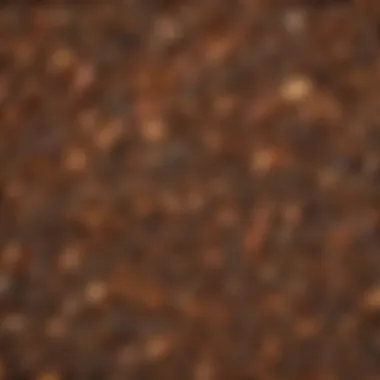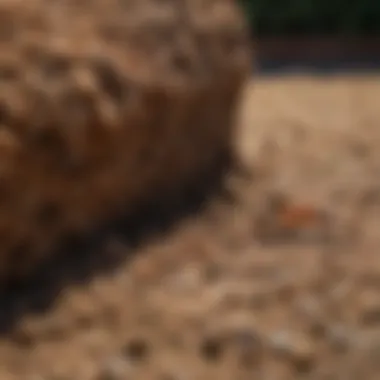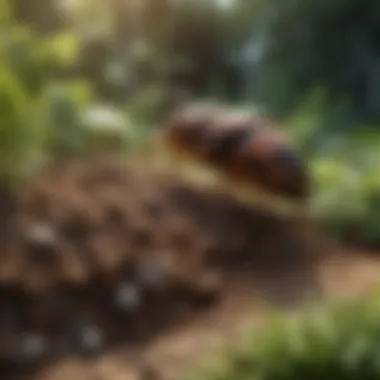Mulch's Impact on Termite Behavior and Management


Intro
Mulch serves as an essential component in landscaping, offering benefits such as moisture retention and weed suppression. However, its relationship with termites is complex. While certain types of mulch can enhance the aesthetics of gardens and flower beds, they may also inadvertently attract pests, leading to potential infestations. Understanding this relationship is crucial for homeowners who wish to balance the advantages of mulch usage while mitigating risks associated with termite presence.
In this article, we will dissect the multifaceted nature of mulch, examining how various types can either repel or lure termites. We will analyze the role of specific materials in fostering a conducive environment for these pests, as well as explore practical prevention and treatment strategies that can empower homeowners.
Pest Identification
Detailed Descriptions of Common Pests
Among the numerous pests that homeowners may encounter, termites are notable for their destructive capabilities. Termites, particularly the Eastern subterranean and Formosan species, are attracted to wood and organic matter. They thrive in colonies which can number in the thousands. Their capacity to tunnel through wood means they can cause significant damage to structures, often without visible signs until the damage has worsened.
Other pests that might be present alongside termites include carpenter ants and wood-boring beetles. Carpenter ants can mimic some of the behavior of termites, but they do not consume wood; instead, they hollow it out to create nests. Wood-boring beetles, depending on their species, lay eggs in wood or mulch and may target weakened or decaying structures.
Signs and Symptoms of Infestations
Identifying an infestation early is critical to preventing extensive damage. Homeowners should look out for several key indicators, including:
- Mud tubes: These are small tunnels made from soil and wood particles, usually found leading to and from wooden structures.
- Live or dead termites: If spotted, this is a clear sign of an active infestation.
- Hollow-sounding wood: Tapping on wood to listen for a hollow sound can indicate that it has been consumed internally by termites.
- Frass: This is the term for termite droppings; it appears as small pellets and may resemble sawdust.
"Regular inspections can help detect pests at an early stage, allowing for effective treatment before significant damage occurs."
Prevention Strategies
Home Maintenance Tips for Pest Prevention
Preventing termite infestations begins with proper home maintenance. Here are some effective strategies:
- Reduce moisture: Fix leaking pipes and ensure proper drainage around the home to minimize moisture accumulation.
- Organic matter management: Regularly turn over and remove excess mulch or organic materials to disrupt potential habitats.
- Foundation inspection: Routinely check the base of the home for cracks or gaps that might allow pests access.
Natural Deterrents and Barriers
Homeowners can employ several natural deterrents to keep termites at bay. Some effective options include:
- Nematodes: These microscopic worms can be introduced into the soil and feed on termite larvae.
- Boric acid: Applying a boric acid-based solution can deter termites when treated wood products are used.
- Essential oils: Oils derived from plants, such as orange oil or neem oil, can act as natural barriers.
Treatment Options
Overview of Chemical vs. Natural Treatments
When dealing with termite issues, homeowners have two primary treatment options: chemical and natural methods. Chemical treatments often involve the use of insecticides designed to eliminate termites directly. Natural treatments focus on disrupting termite behavior or using biological methods to reduce pest populations. Both methods have their pros and cons and should be considered based on the severity of the infestation.
Step-by-step Guides for DIY Treatments
For those looking to undertake treatment at home, here is a simple guide for a natural method:
- Identify the infested area.
- Spray a mixture of boric acid and water on affected wood surfaces.
- Seal the areas after treatment to keep pests from returning.
- Monitor the effectiveness regularly by checking for signs of activity.
Preamble to Termites and Their Habitats
In landscaping, mulch is often used to suppress weeds, retain moisture, and improve aesthetics. However, it can create a habitat conducive to termite activity if not managed correctly. Households experiencing termite infestation may face severe structural damage. Thus, knowing how termites interact with their environments, particularly where mulch is present, is essential for effective management and prevention.
Understanding Termite Behavior
Termites are social insects that live in colonies, typically found underground or within decaying wood. They communicate using pheromones, allowing them to warn each other about danger and locate food. Termites primarily feed on cellulose, which is abundant in wood, leaf litter, and some types of mulch.


By understanding termite behavior, homeowners can implement targeted strategies to mitigate risks. For example, termites are drawn to moisture-rich environments. Mulch can hold moisture, making it a potential attraction. Additionally, they tend to follow scent trails to food sources, which can lead them to structural woodwork in homes if mulch is not placed appropriately.
Common Species of Termites
There are several species of termites that homeowners should be aware of, including:
- Subterranean Termites: These are the most destructive, living underground. They often enter homes through cracks and gaps.
- Drywood Termites: They infest dry wood, building colonies within timber. They don’t require contact with the ground, making detection more challenging.
- Dampwood Termites: These prefer moisture-rich wood and are often found in decaying trees and logs.
Each species has its own habits and risks. Understanding these differences helps in formulating an effective pest control strategy, especially in areas where mulch is used extensively.
The Role of Mulch in Landscaping
Mulch plays a crucial role in landscaping, serving multiple functions that enhance both the aesthetic appeal and the health of gardens and yards. It acts as a protective layer for the soil, moderating temperature fluctuations and maintaining moisture levels. This is particularly important in garden settings, where plant roots need a stable environment to thrive. Additionally, mulch can suppress weed growth, allowing desired plants to grow more freely without competition. These features make mulch an essential tool for both professional landscapers and homeowners looking to improve their outdoor spaces.
When considering the use of mulch, it is wise to think about not just its practical benefits but also the types available. The choice of mulch can affect not just plant health but also pest attraction, particularly with termites.
Types of Mulch Available
There are various types of mulch, each with unique characteristics that can influence both plant health and pest dynamics. Looking at organic options, products like wood chips, bark, and straw are popular choices. Wood chips can offer a rustic appeal while aiding moisture retention. Bark mulch, often derived from pine or cedar, not only adds visual appeal but also emits a natural repellent against certain pests due to its aromatic qualities.
On the other hand, inorganic mulches, such as gravel or rubber, provide durability and do not decompose quickly, hence requiring less frequent replacement. Gravel can be effective in preventing soil erosion but may not offer the same benefits in terms of moisture retention. It's essential to consider how different mulches will interact with the environment, especially in relation to termite activity.
Benefits of Using Mulch
Mulch offers several benefits that can significantly enhance the quality and appearance of gardens:
- Moisture Retention: Mulch helps keep soil damp by reducing evaporation, which can be advantageous during dry spells.
- Soil Temperature Regulation: It insulates the soil, keeping it warmer in colder months and cooler during hot weather, hence benefiting plant roots.
- Weed Suppression: By covering the soil, mulch blocks sunlight that weeds need to germinate, thereby reducing maintenance.
- Nutrient Enrichment: Organic mulches gradually decompose, enriching the soil with essential nutrients, which is crucial for plant growth.
- Erosion Control: It helps prevent soil erosion, particularly on slopes, by reducing the impact of rain on exposed soil.
Mulch not only enhances the beauty of landscaping but also contributes significantly to ecological balance and healthy plant growth.
In terms of termite management, careful consideration should be given to the type of mulch selected. Some mulches may inadvertently create a conducive environment for termite infestations. Thus, understanding both the advantages and potential risks associated with mulch is critical for homeowners.
Mulch as a Contributing Factor to Termite Infestation
Mulch is often considered an essential element in landscaping, yet it can sometimes play a significant role in attracting termites. This relationship is complex and can have both beneficial and detrimental effects on gardens and homes. Understanding how mulch interacts with termite behavior is crucial for homeowners and pest control professionals alike. Certain mulches can create a favorable environment for termites, potentially leading to infestations. Therefore, it is important to assess the type of mulch used and its placement in relation to structural elements of the home.
How Mulch Provides a Favorable Environment
Termites thrive in conditions that offer warmth, moisture, and concealment. Mulch can provide these conditions effectively. When mulch is piled too high or is in direct contact with the foundation of a house, it can trap moisture. This moisture not only benefits the plants but also creates an ideal breeding ground for termites.
Additionally, the organic materials used in many types of mulch can serve as a food source for these pests. As mulches break down over time, they release essential nutrients, which can also attract termites searching for food.
A few factors make mulch particularly favorable for termites:
- Moisture retention: Mulch retains water, causing a humid environment.
- Temperature regulation: It helps maintain moderate temperature under the surface, ideal for termite activity.
- Organic matter: Many types of mulch contain cellulose, which is a food source for termites.
"Maintaining the right balance with mulch can be tricky, but vigilance can prevent infestations."
Types of Mulch That Attract Termites
Homeowners may be unaware that not all mulch is created equal when it comes to termite attraction. Some types of mulch have properties that make them particularly appealing to these pests. Here are a few types of mulch that can increase the risk of termite infestations:
- Wooden mulch: This is often the most attractive to termites. Shredded wood, bark, or chipped trees can provide not only habitat but also a food source.
- Straw and grass clippings: These organic materials decompose quickly and have cellulose that can attract termites.
- Paper mulch: While beneficial in some contexts, paper products can also serve as food, drawing termites in if not properly maintained.
In contrast, non-organic mulches like gravel or rubber can deter termite infestations due to their lack of organic material and moisture retention. Ultimately, the choice of mulch will influence the susceptibility of gardens and homes to termite activity.
Preventive Measures Against Termites in Mulched Areas


Addressing the potential risks of termite infestations is essential for homeowners who use mulch in their landscaping. While mulch offers numerous benefits, it can also create a conducive environment for termites if proper precautions are not taken. Implementing preventive measures helps in significantly reducing the chances of an infestation. This section highlights key strategies to protect your property while enjoying the aesthetic appeal of mulch.
Choosing Termite-Resistant Mulch
When selecting mulch, homeowners should consider materials that are less attractive to termites. Some mulch types, like cedar and cypress, contain natural oils that help resist termite activity. They are less likely to break down quickly, reducing the likelihood of attracting these pests. Organic mulches, such as wood chips from tree trimmings or recycled pallets, are often more appealing to termites and may decompose faster, which increases the risk of infestation.
Here are some recommended termite-resistant mulch options:
- Cedar mulch: Contains natural insect-repelling properties.
- Cypress mulch: Similar benefits due to essential oils.
- Rubber mulch: Inorganic and does not attract termites.
Homeowners should avoid using untreated wood mulch or any mulch sourced from an area known to have a termite problem.
Proper Mulching Techniques
Applying mulch correctly is critical to deter termite infestations. Mulch should be spread evenly and not piled against the foundation of your home, as this can create a bridge for termites to reach your property. The ideal depth for mulch is around two to three inches. This depth provides moisture retention and weed control without inviting termites.
Consider these practices:
- Avoid direct contact: Keep mulch at least six inches away from the foundation.
- Layer strategically: Use mulch in a way that does not touch wooden structures.
- Repair damages: Ensure there are no leaks or damaged wood around your home, as moisture attracts termites.
Maintaining a Distance from Structures
Creating a buffer zone between mulch and the structures of your home is essential in preventing termite issues. Termites travel through the soil rather than openly, so limiting the conditions they find desirable right against your building is a sound strategy. A clear, dry space of six to twelve inches can prevent the easy access termites need to invade your home.
Summary
Keeping your landscaping beautiful and functional while minimizing termite risks is achievable with these guidelines.
Signs of Termite Activity in Mulched Areas
Understanding the signs of termite activity in mulched areas is crucial for homeowners. Early detection can help mitigate damage before it becomes severe. Termites are often silent destroyers, making their presence difficult to detect initially. Failing to recognize these signs can lead to extensive structural damage and costly repairs. Homeowners should frequently monitor their gardens and landscapes for indications of termite infestations, especially where mulch is used.
Identifying Termite Damage
Identifying termite damage requires a careful examination of both the mulch and surrounding areas. Common signs include:
- Mud tubes: These pencil-sized tubes are often found on walls, trees, or within mulch. They serve as passages for termites to travel between their colony and food sources.
- Damaged wood: Look for hollow-sounding wood or wood that appears chewed at the edges. This often indicates termite activity.
- Swarmers: Winged termites, or swarmers, may appear during mating season. If swarmers are noticed in or around your home, it signals a nearby colony.
- Dropped wings: After mating, swarmers shed their wings. Finding these wings near mulch or foundation could indicate termite presence.
Inspecting mulch closely can also uncover telltale signs. When mulch is disturbed, underlying wood may show signs of termite infestation. It's important to differentiate between localized damage to mulch and broader structural issues affecting the home.
Conducting Regular Inspections
Regular inspections are an essential practice for homeowners using mulch in their landscaping. This can help ensure that any signs of termite activity are caught early. Here are some steps for effective inspections:
- Schedule routine checks: Aim to inspect your landscaping at least twice a year, preferably in spring and fall. This timing helps catch termite activity before they enter dormant phases.
- Focus on high-risk areas: Pay attention to mulch beds, in any damp areas, and around the foundation where mulch may be piled too high.
- Use a probe: Gently probing the mulch can help identify areas that sound hollow or feel unusually soft, indicating potential termite activity.
- Inspect moisture levels: Termites thrive in damp environments. Assess your mulch for excessive moisture, which can attract termites.
- Document findings: Keep a record of any signs of damage or activity. This can be beneficial for professional evaluations or insurance claims if damage occurs.
"Early detection is key to controlling termites. Regular inspections can save homeowners considerable trouble and expense."
By regularly inspecting for these signs and staying observant, homeowners can maintain healthier landscaping and protect their homes from termites.
Chemical Treatments and Natural Solutions
In the battles against termites, which are notorious for causing significant damage to wooden structures, both chemical treatments and natural solutions play a crucial role. Understanding these options can help homeowners make more informed decisions. It is vital to know how these methods can complement each other. Each solution carries its own benefits, applications, and considerations that should not be overlooked.
Chemical treatments focus primarily on creating barriers that deter termites from approaching a property. Using specific products and techniques, homeowners can shield their homes from potential infestations effectively. Moreover, chemical barriers can include sprays, liquids, or baiting systems that work specifically to eliminate existing colonies. Homeowners must consider the effectiveness, application method, and any potential impact on the environment when choosing these products.


On the other hand, natural repellents offer an alternative for those seeking eco-friendly options. These can include various natural substances known to repel termites. They range from essential oils to physical barriers made from natural materials. Understanding their effectiveness and proper application can provide homeowners with safe ways to keep these pests at bay. A comprehensive approach that includes both chemical and natural strategies could yield the best results.
"Choosing the right treatment is crucial. No single solution works for everyone; a combination often leads to the best outcome."
Chemical Barriers for Termite Prevention
Chemical barriers are among the most effective methods for preventing termite infestations. These barriers are established through the application of specialized liquid insecticides. These products create a protective zone around a property, reducing the risk of termites finding their way into the home. The most commonly used chemical barriers include fipronil and imidacloprid, among others. They are often applied at the soil level, directly targeting the pathways termites use.
The application of chemical barriers involves several steps:
- Site Preparation: Before applying any treatment, it is important to clear the area of debris and vegetation.
- Trenching: This involves digging around the foundation of the structure.
- Application: Insecticides are injected into the soil, forming a continuous barrier.
- Monitoring: Regular inspections help ensure the effectiveness of the barrier.
Homeowners must carefully follow all instructions during application to ensure safety and effectiveness. Additionally, factors like the environment and soil type can affect the longevity of chemical barriers. For this reason, it is important to consult pest control professionals on the most effective solutions.
Natural Repellents and Barriers
For those looking to avoid chemicals, natural repellents can be an appealing option. These products consist of organic substances that can deter termites without the use of harsh chemicals. Some the popular natural solutions include:
- Essential Oils: Oils such as clove oil and orange oil have been shown to be effective in repelling termites. They can be mixed with water and sprayed around the home.
- Diatomaceous Earth: A natural powder made from fossilized algae, diatomaceous earth can help in drying out pests on contact. It should be applied in areas where termite activity is suspected.
- Nematodes: These microscopic worms are beneficial for controlling termites. They infect and kill termites. Homeowners can introduce them into the soil as a means of biological pest control.
Natural repellents often require more frequent application during higher activity periods. Homeowners should take note of the environmental conditions and reapply as necessary. While the results may not be as immediate as chemical options, the long-term benefits include less impact on the ecosystem and a safer approach for homes with children or pets.
In sum, while chemical barriers provide a strong layer of defense against termites, natural solutions offer a safer alternative with proper management. Combining these strategies can lead to a more robust defense against termite activity.
Professional Pest Control Options
The challenge of managing termites in mulched areas underscores the significance of professional pest control options. Homeowners often feel overwhelmed by the subtle yet impactful role that mulch plays in attracting termites. Understanding when to involve experts can drastically improve the chances of effective pest management.
Termites, being social insects, often require a comprehensive approach for control. This is where professional pest control services come into play. Engaging with these professionals offers custom solutions tailored to specific infestation levels, types of termites, and the surrounding environment.
When to Call a Pest Control Professional
Knowing when to call a pest control specialist can be tricky. Early detection is key to preventing extensive damage. Homeowners should consider seeking professional help if they observe any of the following signs:
- Visible damage: If you notice hollowed wood, sagging structures, or mud tubes extending from the ground to wooden elements, this indicates active infestation.
- Termite swarms: The emergence of winged termites during warm months suggests they are seeking new colonies, often indicating an existing problem in or around your property.
- Frequent sightings: Occasionally spotting termites, especially in proximity to mulched areas, warrants immediate investigation.
Professional pest control technicians can conduct an assessment, identify the species, and determine the severity of the problem. Swift action can save not only the integrity of a structure but also significant financial investment in repairs.
Understanding Treatment Methods
Treatment methods for termites vary considerably based on the species and extent of infestation. A variety of strategies may be employed:
- Chemical Treatments: This often involves the use of insecticides applied directly in the soil or wood. Professionals frequently use liquid termiticides as a barrier against future infestations.
- Baiting Systems: Bait systems are strategically placed around the property and attract termites. Once they consume the bait, it leads to their demise, effectively controlling the colony.
- Fumigation: In severe cases, where the infestation is widespread, fumigation can be the only option. This method involves enclosing the structure and using gas to eliminate termites in all life stages.
- Natural Solutions: Increasingly, pest control specialists may explore natural alternatives, like nematodes or essential oils, offering a less toxic approach to termite management.
"Effective termite control often requires a multi-faceted approach, integrating various treatment methods based on the homeowner's specific situation and preferences."
Understanding the options available can empower homeowners, leading to timely and effective action against termite threats.
Epilogue
The relationship between mulch and termites is complex and multifaceted. Understanding this relationship is essential for homeowners and those interested in landscaping and pest control. Mulch serves various functions in gardens and landscapes, providing aesthetic appeal, moisture retention, and weed suppression. However, it can also create conditions that are conducive to termite infestations. Thus, recognizing how different types of mulch interact with termite behavior is not only beneficial but crucial.
Recap of Key Points
In reviewing the significant aspects discussed, several critical points emerge:
- Mulch Benefits: Using mulch can enhance the health of garden beds by retaining moisture and reducing weed growth.
- Termite Attraction: Certain mulches, such as wood-based options, can attract termites, particularly when they are in close proximity to structures.
- Preventive Measures: Choosing termite-resistant mulch and employing proper mulching techniques can help minimize risks.
- Regular Inspections: Conducting routine checks for signs of termite activity ensures early detection and mitigation.
- Chemical and Natural Solutions: Various treatment options exist for those wanting to protect their homes and gardens from termite threats.
Final Thoughts on Mulch Use and Termite Control
For housewives and homeowners, making informed choices about mulch can prevent potential pest problems before they escalate. It is vital to consider the environment that different types of mulch create. By doing so, one can enjoy the advantages of mulching while minimizing the risk of termite infestations. Overall, proactive management and informed selections are the best strategies for effective termite control.
"Understanding the interactions between mulch and termites allows for better pest management and healthier landscapes."



